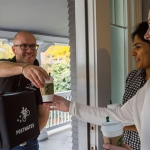Delivering on delivery: 3 pitfalls of traditional third-party delivery platforms

With the rise of the on-demand economy, consumers today expect choice, convenience and control when making dining decisions. In fact, approximately 42 percent of consumers say the ability to order online alone would lead them to choose one restaurant over another. Resulting from this increasing demand for seamless food delivery, many restaurants have partnered with app-based delivery platforms to remain competitive. By leveraging these third-party deliverers, they hope to reap the benefits of the $210 billion dollar food delivery industry, all while avoiding the regulatory and administrative demands that come with having a full-time delivery workforce.
While platforms like UberEats, DoorDash, Postmates, and GrubHub have their advantages, they come with a unique set of challenges. Here are three factors that restaurant operators should consider before joining forces with traditional third-party delivery platforms.
1. Contrary to popular belief, third-party delivery leads to increased costs. As delivery service apps capture a growing percentage of food sales, they ultimately harm restaurants’ profit margins by charging on average 30 percent of their listed prices. To make matters worse, they also encourage consumers to stay home rather than dine out and enjoy the brand-intended restaurant experience, where they would likely spend more money, supplementing their meal with drinks, appetizers, and desserts.
This has created a “necessary evil” for operators who have no choice but to respond to the delivery demand at the expense of their bottom line. While delivery is important for restaurants to address, operators must be aware of the financial impact of these traditional third-party deliverers, especially when there are other delivery platforms available in the market with varying models and offerings.
2. Restaurants lose control of their brand. By outsourcing to delivery services, restaurants lose control of their brand from the moment the food leaves the restaurant to when it arrives at the consumer’s home. As seen with the example of one couple who used UberEats to order a pizza from a nearby restaurant but received two moldy sandwiches and a wilted salad instead, this can have a negative impact on customers’ perception of a business. By placing their product in the hands of a third-party contractor, restaurants risk damaging their continuity, reliability, accuracy, delivery timing and food presentation. Simply put, when a consumer has a bad experience with UberEats or GrubHub, they may associate that experience with the restaurant itself and decide to never reorder, even if the restaurant isn’t at fault.
3. Third-party delivery services sever the connection between restaurant and customer. Fifty-five percent of consumers prefer ordering directly from a restaurant as opposed to a third-party aggregator. A primary reason for this is that they like interacting directly with the brand itself. When restaurants partner with third-party platforms, they cut direct ties with their customers who thus begin to associate the meal they’re enjoying with whichever third-party delivery service brought it to their doorstep. As a result, restaurants surrender their hard-earned customer relationships and valuable data, essentially handing it free of charge to those other platforms. This could eventually open the door for their consumers to be tempted with Uber Burgers and Grub Tacos.
So what is the solution?
How can restaurant owners capitalize on the food delivery trend without cutting into their profits and surrendering their brand control? Directly hiring a part-time delivery workforce isn’t the answer as that creates a separate set of challenges, including high turnover rates, training costs and a slew of administrative employment burdens for the operators.
The gig economy is a powerful concept that’s revolutionizing today’s employment model, but it’s important to be diligent and understand the risks and rewards of partnering with third-party delivery services. There are alternative platforms available that allow restaurants to use their own team members to self-deliver while still enjoying the benefits of the gig economy. Some of these platforms also handle compliance, management and insurance tasks for operators, further alleviating them of the employment-related responsibilities that caused them to leverage the gig economy in the first place. This creates a best of both worlds scenario for operators as well as delivery drivers who can enjoy gig economy-like flexibility.
This article first appeared on FastCasual on June 12, 2018 – Author: Scott Absher, CEO, ShiftPixy

 Previous Post
Previous Post Next Post
Next Post